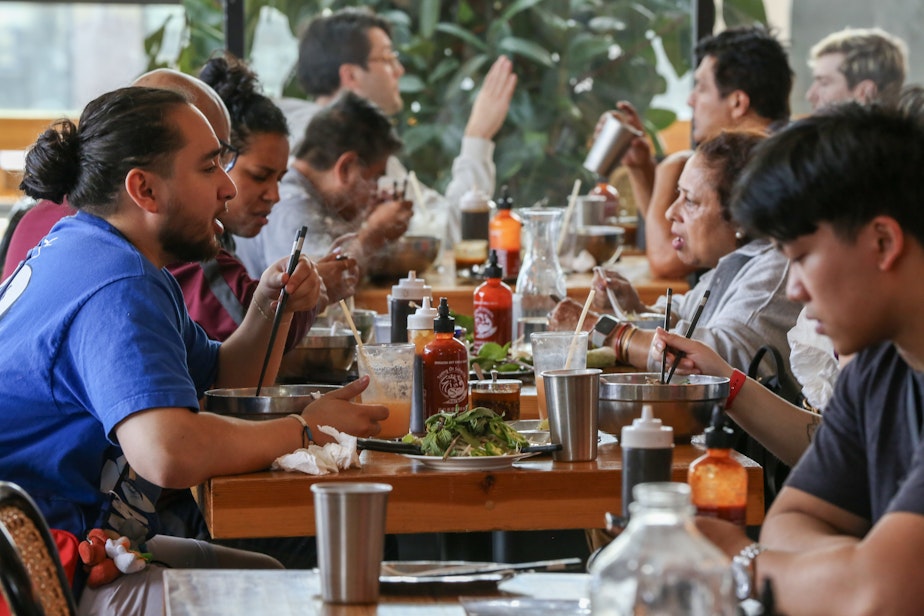There are as many pho restaurants as Starbucks coffee shops in Seattle. Here's why

If an alien landed in Seattle, it might get the impression the city runs on coffee and pho. There are as many pho restaurants as Starbucks coffee shops.
This humble soup, a breakfast staple in Vietnam, has become a Seattle mainstay, thanks to the refugees who made their home in Washington state following the collapse of South Vietnam.
Pho Bac, on the corner of South Jackson Street and 13th Avenue in Seattle’s Little Saigon, is the O.G.
Quyenvy Pham’s parents were part of the first wave of refugees to resettle in Seattle. In 1982, they opened a sandwich shop on Jackson Street called Cat’s Submarine. Pham’s mother would make a pot of pho on weekends for homesick friends when they visited the shop.
“Word just spread,” Pham said, “and they sold more pho than sandwiches.”
Sponsored
Pham said that’s when her parents decided to ditch the sandwich menu for pho. Pho Bac, Seattle’s first pho restaurant was born. Soon, even non-Vietnamese customers started coming in for hot bowls of noodles.
The funny thing, Quyenvy said, is that their mom didn’t cook until they came to America.
“She wrote a letter to a friend back home in Vietnam and asked for the [pho] recipe. From there, she kind of created something of her own.”

More than 40 years later, the siblings have taken over the business, using their mom’s recipe, but with a slight tweak. The original shop, at one time painted Pepto Bismol pink, is now The Boat, serving chicken and rice. But pho continues to flow next door at Pho Bac Sup Shop.
Sponsored
Pho’s appeal remains strong, especially in Seattle.
“We’re moody people in Seattle,” Yenvy Pham, Quyenvy’s younger sister, said. The gloomy weather makes it conducive to eating pho.
“It’s hot, it’s affordable and it’s very satisfying,” she said.
Part of the appeal is how easy it is to customize the soup. “It’s a simple dish, just one canvas,” said Yenvy. “But everyone kind of personalize it in their own way — with different sauces, condiments.”
That seems to be the general consensus. Writer and cookbook author Andrea Nguyen says pho is so Vietnamese, in the sense that you can have it your way. So it makes sense that it would do very well in the U.S.
Sponsored
“It’s also very American in the sense that is about self determination in a bowl of noodle soup,” Nguyen said.
Nguyen said pho originated in the northern part of Vietnam where the soup tends to be plain and more on the savory side.
“You don’t get all the razzle dazzle different cuts of meat as you would in Saigon, the southern part of the country where people like things sweeter.”
Not to mention the different add-ons like bean sprouts and herbs.

Sponsored
“People who have come to the United States, for the most part, initially came from the southern part of Vietnam.”
On the surface, pho looks simple: beef broth, rice noodles, thin slices of beef and herbs. But that simplicity belies the labor and time it takes to making it. A bowl of pho is only as good as its broth.
“Making pho is very much like making wine,” said Eric Banh, executive chef and co-founder of Saigon Siblings.
Banh and I were in the back kitchen at Ba Bar Capitol Hill where two longtime employees watched over simmering stockpots. The scent of cardamom, cinnamon and star anise filled the kitchen.
Sponsored
“Making any soup is much easier than pho because a little bit of off balance, oh my god. And the flames too high, you cloud the soup,” Banh said.
The Capitol Hill kitchen makes 800 gallons of broth each week. Before the bones and marrow hit the stove, Banh said they wash the bones and soak them overnight to remove the impurities, so the broth is less cloudy. After that, the bones are blanched before they’re ready for the main action—a 10 hour simmer.
Banh was the first in Seattle to charge $10 for pho, reflecting the labor and quality ingredients. This was in 2013. He was unapologetic then and remains so.
“Nobody complained about French onion soup for being a quarter of that size and cost the same if not more,” he said.

Plus, it’s not something that can be easily whipped up at home.
“I promise you, [even if] you follow our precise instruction and recipe, it costs you more to make it at home.”
Pho is embedded in the Seattle area’s palate even Costco sells instant pho at certain Puget Sound area locations.
While pho can be customized to one’s taste, Banh and Nguyen suggest tasting the broth first before adding any sauce or condiments. By the way, the hoisin sauce and siracha are meant as a dipping sauce for the meat.
If you do use condiments on the soup, go easy on it, Banh said. “Don’t put so much that you ruin 12 or 15 hours of a restaurant’s work.”




